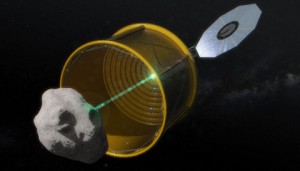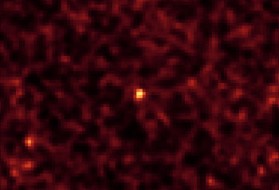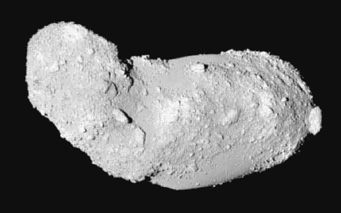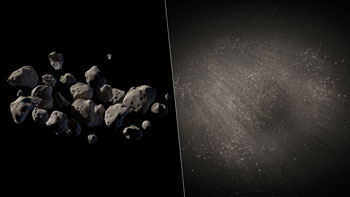Despite skepticism from scientists and politicians alike, NASA is proceeding with its asteroid redirect mission and has found six candidates for exploration so far.
Usually, the saying goes, getting there is half the battle. In the case of NASA’s Asteroid Redirect Mission (ARM), finding “there” might be the bigger challenge.

NASA
When NASA first announced the mission to find, retrieve, and explore an asteroid, the community reacted with skepticism. Finding asteroids, especially small ones, is hard — and finding small asteroids with just the right criteria for a robotic rendezvous is even harder. An alternative option, flying to a bigger asteroid and retrieving a boulder off its surface, was even added as a possibility to help enlarge the pool of candidates.
Now NASA has announced that they have collected six “valid candidates” between the two options, where “valid” indicates that follow-up observations show the objects meet rendezvous criteria.
For Option A, which aims to bag a whole, small asteroid and bring it back to lunar retrograde orbit, the three criteria are size, spin rate, and mass. Mission planners have three valid candidates so far: 2009 BD, 2013 EC20, and a new candidate announced yesterday, 2011 MD. Each candidate is less than about 10 meters across and spins less than once every 2 minutes. The mass limit depends on the asteroid’s orbit.

NASA / JPL-Caltech / Northern Arizona University / SAO
2011 MD, the biggest candidate so far, is between 4 and 10 meters across (13 to 32 feet) and has a surprisingly low density, roughly that of water. Based on the size and density, its mass is somewhere between 50 and 350 tons. This asteroid passed very close to Earth in 2011, enabling its discovery and tweaking its orbit such that it’s a good target for a rendezvous in 2024.
Earlier this year, NASA’s Spitzer Space Telescope, whose orbit trails Earth’s, stared at 2011 MD for 20 hours to characterize the object’s temperature, and therefore its size. The low density probably means that the asteroid is really a fleet of flying boulders, though it’s also possible that the asteroid is a single rock surrounded by a haze of smaller rock particles.
Regardless of the asteroid’s true nature, Option A would have the robotic spacecraft grab the whole thing in a bag and haul it back to an orbit 70,000 km above the lunar surface.

JAXA
The alternative, Option B, involves retrieving a boulder from a larger asteroid and has fewer constraints, requiring only an accessible orbit and confirmation of boulders on the asteroid’s surface. But observational evidence for boulders is hard to obtain. So far, three candidates have made the list for Option B: Itokawa (pictured at right), 2008 EV5, and 101955 Bennu, the target of the upcoming OSIRIS-Rex mission.
In addition to widening the playing field of potential targets, Option B has a side benefit: testing planetary defense. Option A by definition has NASA targeting asteroids that are too small to matter when it comes to close encounters — if these asteroids ever ventured too near Earth, they would mostly burn up in the atmosphere. But Option B targets asteroids 100 times larger, and the robotic spacecraft could demonstrate techniques such as the gravity tractor or ion-beam deflection either before or after picking up the boulder.
Paul Chodas (NASA JPL) estimated that NASA’s searches might find an additional two to three candidate asteroids per year until 2018, at which time the agency will have to decide both which option they’re going with and which asteroid they’ll target for a projected 2019 launch.
As the search for asteroid candidates continues, work begins on retrieval mechanisms. NASA also announced yesterday 18 proposals that will share $4.9 million over the next six months to investigate technology for rendezvous sensors, asteroid capture, adapting commercial spacecraft, and more. See NASA’s press release for the full list of accepted proposals.
Facing the Skeptics

NASA / JPL-Caltech
NASA’s announcement was intended no doubt to soothe critics in the political and scientific communities alike. Just last week, the U.S. National Academy of Sciences issued a report that urged a return to the Moon rather than a singular focus on asteroid retrieval. Meanwhile, lawmakers have voiced their unease about the asteroid retrieval mission’s lack of a firm schedule and budget.
“Our briefing reminded the community that we have some viable candidates already for this proposed mission,” Chodas says, “and the prospects are good for finding more viable candidates.”
But Jim Bell (Arizona State University), president of The Planetary Society, counters, “Finding suitable targets is just one step in NASA proving that the Asteroid Retrieval Mission is a feasible project.” As described in a recent statement from The Planetary Society, the agency also needs to produce an independent assessment of the mission’s likely costs and of the technical implementation that NASA plans to pursue, he explains. “Hopefully those additional steps will be coming soon.”
We'll soon get our first close glimpse at another alien interplanetary visitor, Comet 67P/Churyumov–Gerasimenko — subscribe to Sky & Telescope and take a sneak peak at the Rosetta mission with our August 2014 issue.
 6
6









Comments
Patrick-McDonald
June 20, 2014 at 4:45 pm
“If at first the idea is not absurd, then there is no hope for it.” Albert Einstein. Let's do this. Future generations may have reason to thank us.
You must be logged in to post a comment.
June 27, 2014 at 5:23 pm
Here Here For Sure lets do this, I'm happy to hear they are going to go ahead with it.
You must be logged in to post a comment.
June 28, 2014 at 12:07 am
Forgive me for doubting that the depiction of the loose rubble pile explaining the low density of asteroid 2011MB has wings. A consolidated pile perhaps but not a "fleet of flying boulders". I fail to see how that could persist. Mutual low speed collisions would surely result in the bulk of boulders eventually coming to rest upon each other with a few escaping the low gravity system altogether. Depending on the total angular momentum there would be either a single or binary object at the end of the process. As for the cloud well it is much the same. It would not persist. A low gravity aggregation of boulders could easily contain enough void space to account for the low density of the object without resorting to ideas of fleets and clouds.
You must be logged in to post a comment.
Donald W.-Bennett
June 29, 2014 at 12:11 pm
I don't agree with the NAS on much but I do on this one. Go back to the Moon first. Test all the things you'll need for asteroid, Mars, etc, missions in a place close to Earth. That has many advantages including fast communication times, relatively quick response to needed spare parts, etc., the ability to get someone or everyone home in a few days could be a lifesaver, plus more I can't think of at the moment. Also, think about the ordinary folk's ability to just look up at the Moon and say there's someone up there. There would be no need to try to point out an asteroid or Mars or any obscure point in the sky to say "They're right up there. Just to the left of that bright spot.", or wherever.
You must be logged in to post a comment.
Kevin
June 29, 2014 at 1:20 pm
Let's use a two-part spacecraft that would land on an asteroid (which we've already done, whereas we haven't towed one back) drill out a small core (using tried and thoroughly tested rover technology) and then return a sample home. However, given the wide varieties of structure we've detected in asteroids (i.e. a rubble pile, low or high density solid rock or rocky/ice), analyzing the make up of the one we select wouldn't necessarily tell us very much about the others out there and begs the question of spending limited funding on a sample return mission in the first place.
A second part of the spacecraft would stay on the asteroid and use an ion engine to nudge its orbit enough to test that method for deflecting any asteroids that get too close for comfort. Mining asteroids is too far in the future to worry about now--what we need to focus on in the short-term is how to accurately deflect one.
You must be logged in to post a comment.
June 30, 2014 at 8:02 pm
I like Kevin's idea of a two-part spacecraft with a dual mission of composition analysis and deflection system testing. The Moon, like Mars, can wait - they'll both be there when we've evolved sufficiently to have put an end to current global self-destructive human behaviors. But defending Earth from the ever-present possibility of a civilization destroying impact from space is a far wiser investment for limited funding IMHO, even if it isn't very sexy with the average taxpayer. Heck, the Iraq War is now sneaking back into the funding picture, and that certainly has no taxpayer sex appeal anymore. Sometimes you just have to bite the bullet and deal with the big threats before you can justify going on a Cosmic Camping Trip to gather rocks, leave footprints and take selfies. Don't get me wrong... exploring the Solar System & beyond is the destiny of a sentient species - but we've been demonstrating a severe lack of sentience lately, and there are pressing problems on the Homeworld that need funding RIGHT NOW! A cosmic collision security system is a way smaller investment than going back to the Moon or trying for Mars, and the payoff could be huge if it ever has to be deployed for a world-threatening situation. Let's pay the homeowners insurance first, then we can go on the dream around the world cruise later.
You must be logged in to post a comment.
You must be logged in to post a comment.